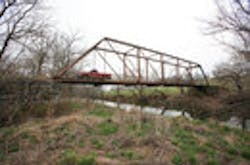Disproportionately high traffic fatality rates, significantly more deficiencies, and an inability to handle rising freight volumes are just some of the critical problems afflicting the network of rural roads and bridges in the U.S., a new report finds.
The report, Rural Connections: Challenges and Opportunities in America’s Heartland, raised several red flags concerning the current state of rural roads and bridges across America. It was produced by The Road Information Program (TRIP).
First, rural traffic fatalities are three times higher than all other roads. TRIP found that in 2009, non-interstate rural roads had a traffic fatality rate of 2.31 deaths per 100 million vehicle miles of travel, compared to a fatality rate on all other roads of 0.75 deaths per 100 million vehicle miles of travel.
And although they carry only 25% of all vehicle miles of travel in the U.S., 51% of the nation’s 33,808 traffic deaths in 2009 occurred in crashes on rural roads.
Second, there’s a greater and increasing level of deterioration among rural roads and bridges compared to all other U.S. roads, according to TRIP’s research. In 2008, 12% of the nation’s major rural roads were rated in poor condition and another 43% were rated in mediocre or fair condition. In 2010, 13% of the nation’s rural bridges were rated as structurally deficient and 10% were functionally obsolete, the group found.
Finally, existing rural roads networks are insufficient to support economic growth and mobility demand, noted TRIP, which is a critical problem as America’s rural heartland is home to approximately 50 million people and its natural resources provide the primary source of the energy, food and fiber that supports the nation’s economy and way of life.
“Rural roads are increasingly serving as the primary connectors for transporting energy, food, and fiber,” said Frank Moretti, TRIP’s director of research and policy, in a conference call with reporters. “For example, we’re increasingly producing energy from states such as Wyoming, North Dakota, and Montana, where rural roads have gone from light use to handling significant numbers of large freight vehicles – and they are not built to handle it.”
Moretti told Fleet Owner that one of the issues accelerating the problem is that over the last two decades, about 100,000 mi. worth or railroad lines were removed from rural areas across America. Now, with energy production in particular increasing in rural locations across the U.S., the only transportation option is the rural road network.
“This lack of connectivity is a growing problem because rural roads can’t accommodate the growing demand for freight travel, among other mobility needs,” he explained.
“So much of the nation’s commerce now moves along back roads,” added Stephen Sandherr, CEO for the Associated General Contractors of America (AGC), who also participated on the call.
“That’s why every aspect of the U.S. economy suffers if we don’t make improvements to our rural road network,” he stressed. “That’s also one of the impacts from having the surface transportation bill languish for two years as Congress can’t find a way to settle their differences. It’s tantamount of economic malpractice.”
Brad Sant, vp-safety and education for the American Road & Transportation Builders Assn. (ARTBA), also noted that the deteriorating condition of many rural roads and bridges has greater impact on the movement of freight and workday commutes than in urban areas.
“In our metropolitan areas, for example, if a road is closed or a bridge is out, there’s usually an alternate route nearby, maybe 5 mi. or so away,” he said. “But in rural areas, if a bridge is out, the only other crossing might be 50 mi. or more away. That creates significant delays for emergency responders, increases the use of fuel, the cost of shipping goods, etc.”
About the Author
Sean Kilcarr
Editor in Chief
Sean Kilcarr is a former longtime FleetOwner senior editor who wrote for the publication from 2000 to 2018. He served as editor-in-chief from 2017 to 2018.
